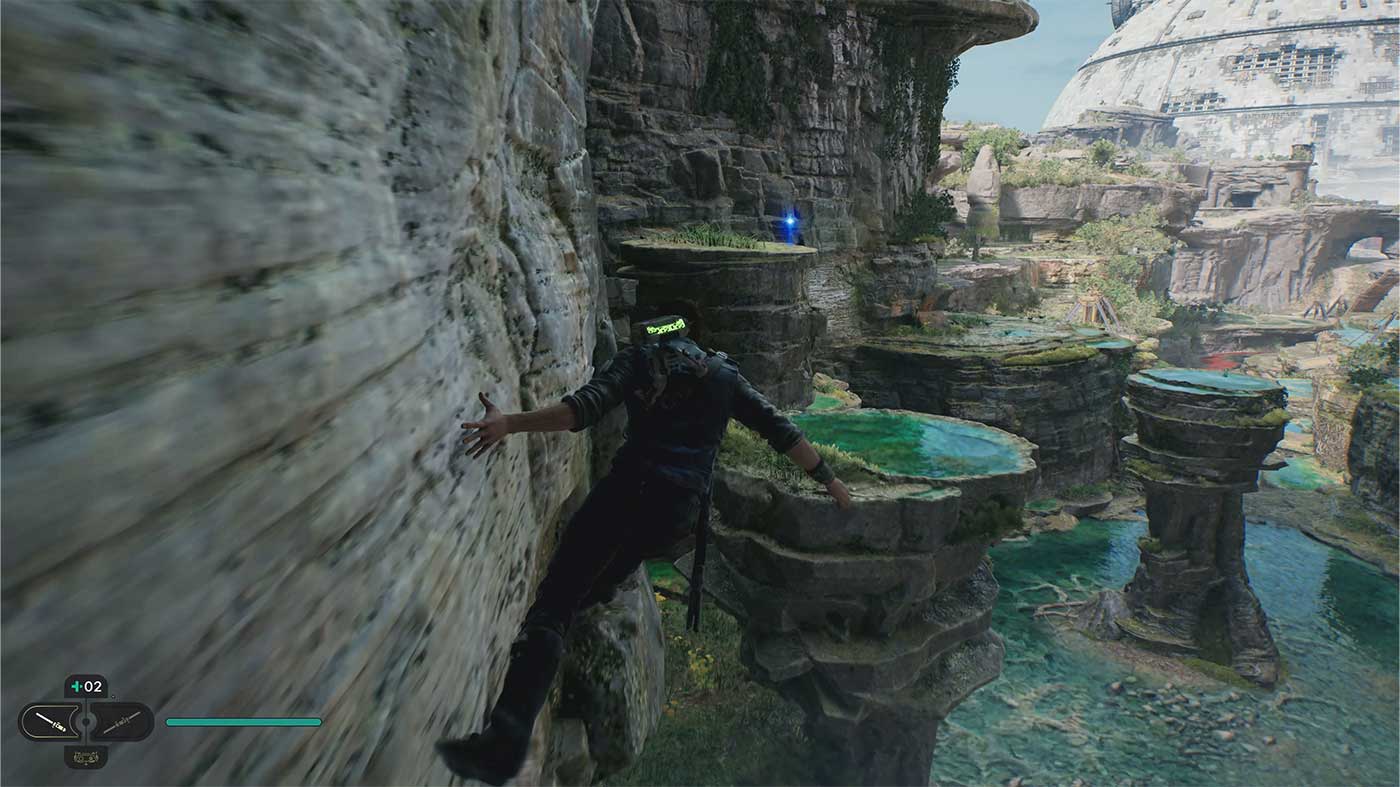Star Wars fans love a dark middle chapter. There’s a reason some forty-odd years later you still hear about The Empire Strikes Back during discussions of the best of the series. The fresh-faced heroes are now hardened by years of war, the encroaching darkness is closer than ever, and nothing is quite what it seemed. With Star Wars Jedi: Survivor, Respawn Entertainment may have made its Empire Strikes Back.
In a recent hands-on session hosted in Los Angeles, we had a chance to play a solid three hours of the game’s opening act. In it, we saw a very different Cal Kestis, this time on a strange new quest that ripples through decades of Star Wars storytelling. It’s bigger, bolder and more ambitious than its predecessor and after some time with its finer details, I’m all but convinced this is the Star Wars game I’ve been waiting for.
VIDEO PRESENTED BY PLAYSTATION VR2. CLICK TO LEARN MORE.
I was cooler on Star Wars Jedi: Fallen Order than most. Despite rave reviews and massive commercial success, I always felt as if something was missing from Respawn’s first crack at a Jedi story. While it chased the highs of FromSoftware’s Souls combat and attempted the cinematic language of the galaxy far, far away, I couldn’t help but see emulation rather than proper fruition. Jedi: Survivor feels designed to address every point of contention players like me could have had with the first game, resulting in a new entry that builds on the solid foundations of the first while escalating the stakes, and quality, exponentially.

It’s been five years in-universe since we’ve linked up with Cal Kestis and that time has dramatically changed our lead Jedi. Years of struggle against the Empire have hardened Cal into a gruffer version of himself, no longer a boy on the run but a man at war. To keep pace, Jedi: Survivor has expanded its combat and exploration mechanics to match this new, more confident Cal. Our demo set us loose on Koboh, an arid planet that housed an expansive open-world environment with pockets of lush vegetation and some truly delightful mysteries. We also had access to three of the five combat stances in the game; whipping around a single Lightsaber, dual sabers and the sick double-edged blade that dominated my playstyle.
THE CHEAPEST PRE-ORDER: $84 AT AMAZON WITH FREE SHIPPING.
Moment to moment combat is a fully realised Jedi power fantasy as Cal is equipped with countless animations that see him weaving between foes, the saber a fluid extension of his movements and in turn your inputs. Across the board the game feels more responsive than the first, faster to react to player choices but still committed to inputs, a balancing act between the precision of the game’s Souls inspirations and the free flowing fun of Star Wars’ more arcade-y games like The Force Unleashed. Enemy collision has been improved from the first game too, blows now landing with a more satisfying thud and eventually cleaving off limbs this time.
Each combat stance has been given its own bespoke skill tree for deeper player expression; something Respawn told me they were the most excited for players to experience. Skill points are still earned through combat and exploration but feel far more valuable this time around as your preferred stance can be radically beefed up with proper investment.
Over time I was able to use the Force, still a limited but rechargeable resource here, to twirl my saber into a colourful windmill, while other stances allowed for automatic parrying and the classic saber toss. While these low level skills were enjoyable enough, we were also shown footage of late-game play that incorporated the remaining two stances, a heavy hitting cross-guard saber and the absurdly cool blaster and saber combination.
In the hands-off demo we saw Cal handling dozens of troopers with ease, deploying an overwhelming amount of Force skills to crowd control while using the saber in escalating, creative ways. This footage included the use of the game’s new Perk system, slots that allow for passive and active combat enhancements like increased block duration.

The blaster will undoubtedly be the headline attraction here, calling to mind the interruptive parrying of Bloodborne’s off-hand pistol, but this time paired with a straight-up Dead Eye slow down ala Red Dead Redemption. It was an immaculate display of force, all but guaranteeing that while Jedi: Survivor is angling for a darker vibe, you’ll still be treated to some childlike wonder in the face of its many combat options.
A Jedi’s arsenal extends beyond their saber though and Jedi: Survivor has taken its expansive approach to skill trees and equally applied it to Cal’s Force abilities. For those concerned that the game would require you to re-learn skills from Jedi: Fallen Order, fear not. The game begins with no unmapped buttons, all your base abilities still present here including staples like Push, Pull and Slow.
These classics are revitalised through customisation, with new skill tiers allowing for more precise deployment for both offensive and defensive play. Often I would roll into a group fight, pinning one trooper against the ground while using the Force to yank another toward me, impaling him before twirling the saber in an exaggerated “come and get me” fashion – all in the span of a few seconds.

Maybe most intriguing of all though is Jedi: Survivor’s adapted approach to violence. Call me a softie but I always found the wanton animal killing in the first game to be a little distasteful, especially considering the Jedi’s creed. Seems like someone at Respawn agreed as now Cal can use the Force in creative ways to pacify not only animals but all sorts of foes. Holding down a bumper transforms the face buttons into higher level skills, like the impossibly useful Jedi mind trick that can turn foes into allies and even tame wild animal life.
In what can only be described as Star Wars’ answer to a Chocobo, Cal can tame wild Nekko, large creatures that you can ride to reach new locations and generally move much faster through the world on. Cal can use this newfound wildlife appreciation to tame flying mammals too, allowing for soaring, cinematic rides across vast stretches.
These creatures are an essential new component of Jedi: Survivor’s refreshed approach to world traversal and map design. Given the expanded nature of the game’s new worlds, of which we hear there are many and are far larger than we’re anticipating, Cal needed updated movement systems to match the scale. The best example being that the first game required you to hold the interact button to remain attached to climbable surfaces but Jedi: Survivor does away with this, meaning Cal can effortlessly move between spaces far faster. Throughout the world you’ll also find specific instances where Cal can use his new hook-shot to get through tightly timed puzzles and find hidden areas.

Exploration is consistently rewarded, both mechanically and in just outright Star Wars vibe-y goodness. Cal can find Health Essence in the world to boost his overall health (along with the Force meter, both of which also feature their own skill trees), as well as cosmetic items and, most importantly, settlement upgrades. Koboh looks to be something of a home for Cal in the game, with the Rambler’s Reach settlement housing a cantina he can upgrade over time into a hub of NPCs, shops, and personalised living quarters. Cal can find seedlings out in the world and plant them in a rooftop garden here too, allowing BD-1 and you the chance to craft your own little slice of paradise, another expansion on the first game’s Mantis planters.
There are about a dozen things in Rambler’s Reach, and Koboh at large, that I want to celebrate here. This place radiates cowboy Western energy from the moment you step foot in it, rescuing the locals from a rampaging raider in a very slick stand-off that only serves to further remind you how far Cal has come as both Jedi and general badass. Typical touches like easter eggs and fan-favourites are easy enough to spot but it’s the deeper cuts that make Jedi: Survivor’s world feel like a genuinely inhabited space.

On my way into town, I ran into a young girl named Mosey, a local farmer who raises Nekko and spoke with a warm, country twang in her voice. Nearby I found roaming raider gangs and quest giving characters in need of help. Cal’s Force Echo returns too, with one particularly killer moment showing me an echo of a local droid repairer working on a busted Separatist unit that quietly chirped at her about the Clone Wars – “Did we win?”
It’s difficult to talk about the story of Jedi: Survivor without straying into spoiler trouble but from what we’ve seen, Cal’s journey is set to catapult him into the farthest corners of Star Wars canon. The familiar touchstones of Empire and Sith Inquisitors in Jedi: Fallen Order were an enjoyable launching pad but it’s thrilling to see Cal navigate a whole new version of this galaxy. Lucasfilm has semi-recently launched its new canon timeline, The High Republic, and this largely book-focused venture will be playing a major role in the events of Jedi: Survivor.
Keen-eyed fans have already spotted the aesthetic signatures of this era in trailers for the game, a mere glimpse at the depth to which Respawn have incorporated these new ideas into its version of Star Wars.

I came away from my time with Jedi: Survivor a rambling mess of thoughts, half of which I haven’t even been able to address here. The game feels familiar but almost entirely unmoored from the trappings of the original, able to strike its own unique visual and mechanical vibe that honours the best of its predecessor but pushes its ideas and characters into far cooler new territory. It can be next to impossible to follow up on a beloved first entry but Star Wars Jedi: Fallen Order looks set to stake its claim as the bold, dark and deeply interesting middle chapter of Respawn Entertainment’s own potential Star Wars trilogy.
Star Wars Jedi: Fallen Survivor is coming to PS5, Xbox Series X|S and PC on April 28th. The cheapest pre-order is $84 Standard Edition / $114 Deluxe Edition from Amazon with free delivery.



